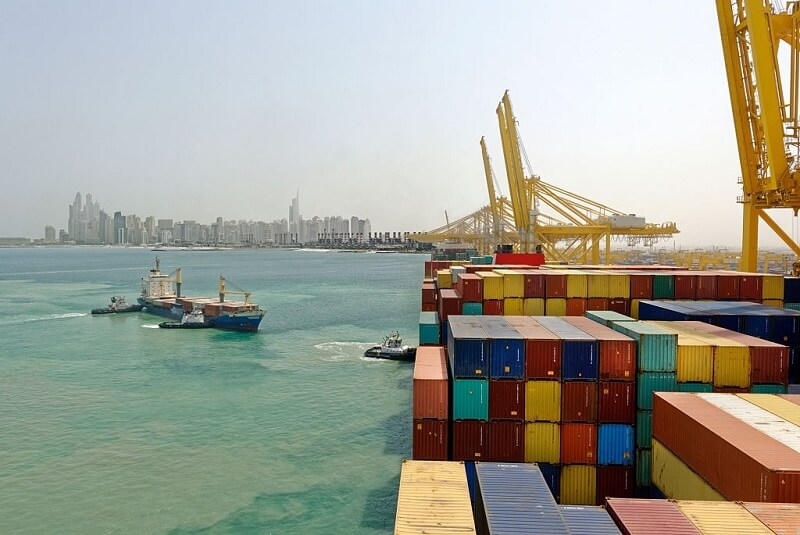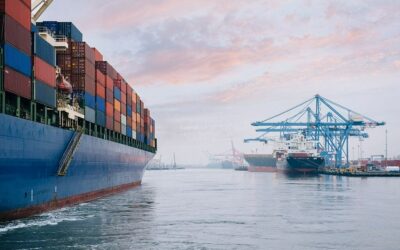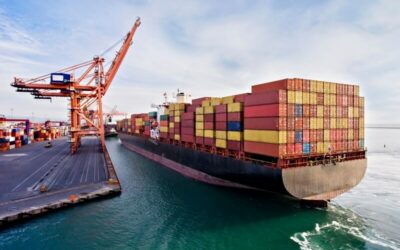Shipping From Australia to UAE : Transit Time, Cost, Procedure | The Ultimate Guide
Australia, the oldest continent, has the greatest mass of coral (The Great Barrier Reef) in the world and is one of the world’s foremost tourist attractions.
Also, It’s part of the Asia-pacific economic cooperation (APEC), the comprehensive and progressive Trans-pacific partnership (CPTPP), and the Regional Comprehensive Economic Partnership (RCEP).
This article will dig deep into how to export your goods from Australia to the UAE, which modes of transportation to choose, cost, transit time, customs clearance in the UAE, major seaports, airports in both countries, and the most important thing is how to choose air or ocean freight.
As previously stated, Australia, the continent, and the country have a huge potential market in Asia and the highly competitive industrialized economies of China, Japan, South Africa, and Taiwan.
Furthermore, the UAE is the ninth-largest host country for Australians, the 15th largest trading partner, and the 10th largest foreign direct investment partner.
Now, Let’s talk about the mode of transport between UAE and Australia:
Table of Contents
What are the Different Options for Shipping from Australia to the UAE?
In the Middle East, the UAE is Australia’s largest trading partner and Australia is a popular holiday destination for Emirates.
So the fact is, Australia has a marginally bigger market share of imports into the Middle East than Canada, Brazil, or South Africa. Shipping from Australia to UAE, there are two ways of shipping goods:
- Ocean freight from Australia to UAE
- Air Freight from Australia to UAE
Even though sea freight can be usually less expensive than air freight, you must first grasp how both are calculated.
As we know, Airfreight is efficient, especially when using a direct service. Things can arrive at their destination within hours or days of being sent, but sea freight might take weeks or months depending on the routing.
On the other hand, For companies that wish to import a huge quantity of products. Sea freight has been reported to be four to six times less expensive than air freight. Furthermore, duty and VAT are computed and spread on the overall quantity shipped hence per unit cost is much less on ocean freight than it is on air freight, lowering overall expenses.
But, the decision between air and ocean freight is sometimes more tricky than it appears. The cost of capital is another thing that must be considered. Long sea shipments are not ideal for items with a limited shelf life, particularly because marine freight is more prone to delays.
In the case of ocean freight, delays are generally measured in days. Furthermore, unlike planes, ships are frequently late. As a result, switching to sea freight is not always a smart decision in terms of quality enhancement or innovation.
Shipping by the ocean is frequently considerably cheaper for huge, heavy items. However, when the quantity of a package diminishes, the price difference between air and ocean shipping reduces as well.
When you choose sea freight, you must know about the FCL and LCL. So, you can read more about How FCL And LCL Works.
What Would be the Cost to Ship Cargo from Australia to the UAE?
The cost of shipping from the United Arab Emirates to Australia is determined by the item being sent and the service (sea/air) selected. The ultimate shipping cost is determined by the packed items’ size and whether they will be transported in a box or a container.
The UAE has the benefit of operating more than 30 free trade zones. So, if you are shipping goods into FTZ, you don’t have to pay any VAT or duty.
When comparing the other regional markets it takes a long transit time and cost to ship your goods from Australia to UAE.
As we know, Cost doesn’t stay static, so you can get accurate details from any reliable freight forwarder. Container shipping to the UAE from Australia can be more economical than air shipping.
What Will be the Transit Time to Ship Cargo from Australia to UAE?
No doubt, air freight is far better when it comes to speed and time. But if you have time to wait, you should choose ocean freight to ship your goods from Australia to Dubai.
Shipping from Australia to UAE is slow, containers can take several weeks so in this case, air shipping takes less time, it’s more reliable and safe but expensive.
Following are transit time details from top Australian ports to Jebel Ali, Dubai.
Sea Freight Transit Time for Direct FCL
| Fremantle to Jebel Ali | 20 days FCL |
| Adelaide to Jebel Ali | 27 days FCL |
| Brisbane to Jebel Ali | 25 days FCL |
| Sydney to Jebel Ali | 26 days FCL |
| Melbourne to Jebel Ali | 26 days FCL |
Air Freight Transit Time
| Melbourne to DXB | 2-3 days |
| Sydney to DXB | 2-3 days |
Oftentimes, due to unforeseen circumstances, your shipment could be late. So, you need to take shipping services to avoid complexities. A trusted shipping expert has a specialty to give a quality assurance that your items arrive as fast as possible, and time-sensitive packages will get a guaranteed delivery time or packing of any breakable goods or fragile items will be taken care of.
What are the Busiest Cargo Ports in Australia?
Some of the busiest cargo ports in Australia are:
- Port Hedland 452,940 tons cargo
- Port of New Castle 163,906 tons cargo
- Port Dampier 160 926 tons cargo
- Port of Hay Point 115,932 tons cargo
- Port of Gladstone 104,629 tons cargo
- Port of Brisbane 37,163 tons cargo
- Port of Melbourne 35,503 tons cargo
- Fremantle Port 31,981 tons cargo
- Port of Sydney 20,618 tons cargo
Port of Hedland
It’s the biggest port in the whole Oceania region
It handles 452 million tons of cargo
Located at West Coast of Australia
Annual trade 110 million tons
Port Dampier
The second-largest port in Australia
It’s located on the Western Coast of Australia near port Hedland
It handles 169 million tons annually
Port of New Castle
It was the first commercial export port in Australia and the world’s busiest coal export as well
Located in New Castle, New South Wales Australia
4,600 ship movements and 171 million tonnes of cargo each year
$25 billion annual trade
Australia’s third-largest port by volume
Port of Gladstone
It’s the largest multi-commodity port in Queensland
It has the fourth-largest coal exports terminal
50 million coal passes through from this port
Located at North East Coast of Queensland
Port of Hay Point
One of the largest coal export ports in the world
Located in South of Mackay Queensland, Australia
It’s two separate coal terminals
46 million annual throughputs in 2020
What are the Major Airports in Australia?
Some of the biggest airports in Australia are:
- Sydney Airport Sydney/ New South Wales
- Melbourne Airport Melbourne/ Victoria
- Brisbane Airport Brisbane/ Queensland
- Perth Airport Perth/ Western Australia
- Adelaide Airport Adelaide/ South Australia
Sydney Airport (SYD)
Airlines (47)
Sydney (City)
Destinations (85)
Terminal (3)
Handles 44 million passengers annually
Hub→ JetStar/ Qanta / Regional Express Airlines/ Virgin Australia
Melbourne Airport (MEL)
Airlines (33)
Melbourne (city)
Destinations (55)
Handles 37 million passengers annually
Hub → JetStar/ Qantas / Regional Express/ virgin Australia
Brisbane Airport (BNE)
Airlines (36)
Brisbane (city)
Destinations (60)
Terminal (2)
Handles 23 million Passengers annually
Hub → Alliance Airport/ Jetstar/ Qantas / Toll Aviation / Virgin Australia
Perth Airport (PER)
Airlines (27)
Perth (city)
Destinations (38)
Terminal (4)
Handles 12 million passengers annually
Hub → Alliance Airlines / Qantas / Virgin Slippers Aviation /Cobham
Adelaide Airport (ADL)
Airlines (15)
Adelaide (city)
Destinations (26)
Terminal (1)
Handles 8 million Passengers annually
Hub → Virgin / Jetstar / Regional Express
What are the Busiest Cargo Ports in the United Arab Emirates?
Apart from oil ports, the UAE has 12 commercial trading ports. That has 310 berths and an 80 million tons cargo capacity. For 40 years, the Zayed Port in Abu Dhabi city served as the emirate’s principal general cargo port. The following are the UAE’s major seaports:
- Port Khalifa (AEKHL) Abu Dhabi
- Mena Zayed (AEMZD) Abu Dhabi
- Mussafah Port (AEAMF) Abu Dhabi
- Port Jebel Ali (AEJEA) Dubai
- Mina Rashid (AEDXB) Dubai
- Mina Al Hamriya ((AEHAM) Dubai
- Port of Fujairah (AEFJR) Fujairah
Port Khalifa (AEKHL) Abu Dhabi
420 square kilometers (Area)
Al Taweelah area in Abu Dhabi. (location)
Serves over 25 shipping lines
Provides direct connections to more than 70 overseas countries.
Mena Zayed (AEMZD) Abu Dhabi
25 square kilometers (Area)
Stores up to 15,000 TEUs
It offers a chilled storage zone that can accommodate more than 15,000 tons of frozen imports and exports.
Mussafah Port (AEAMF) Abu Dhabi
Musaffah Industrial Zone (Location)
The 2nd oldest port in Abu Dhabi
53-kilometre Musaffah Channel (Area)
Link with Jebel Ali and Mina Khalifa
Port Jebel Ali (AEJEA) Dubai
A hub for companies international and domestic both
It has a container freight station (CFS) that handles LCL container units.
Connected to the Dubai International Airport
It handles deliveries to Asia, the Middle East, Northern Africa, and Europe.
Ultra Large Container Vessels (ULCVs) that store over 18,000 TEUs
What are the Major Airports in the UAE?
The United Arab Emirates has nine airports. Here’s an overview of the world’s most well-known airports for foreign flights.
| IATA | Name | City | Airlines | Destinations |
| DXB | Dubai International Airport | Dubai | 84 | 188 |
| AUH | Abu Dhabi International Airport | Abu Dhabi | 58 | 87 |
| SHJ | Sharjah International Airport | Sharjah | 16 | 78 |
| DWC | Al Maktoum International Airport | Jebel Ali | 11 | 40 |
| AAN | Al-Ain International Airport | Al-Ain | 2 | 2 |
| FJR | Fujairah International Airport | Fujairah | 1 | 1 |
| ZDY | Delma Airport | Delma Island | 1 | 1 |
What Documents are Required for Customs Clearance in the United Arab Emirates?
Import Declaration application for UAE Customs clearance is submitted online at dubaitrade.ae by the importer. While filling out the Customs Import Declaration for restricted products or duty-exempt freight, the importer must obtain a valid license from the authorized permit-providing authorities.
Following valid documentation are necessary for importing goods into the UAE:
- Commercial invoice
- Certificate of origin
- Detailed packing list
- Import permit from the competent agencies
- Original bill of loading
- A form or letter of exemption from customs duties
Read the Full Guide: Custom Clearance In UAE | A Step-By-Step Guide
Which One is Better: Sea Freight VS Airfreight?
From Australia to UAE, air freight and ocean shipping, the two most common means of transporting products between continents, have advantages to consider before deciding on one.
Freight is frequently the most expensive part of the supply chain. Businesses will have to be concerned about the elements of freight and the accompanying hidden expenses that may influence their bottom line. Costs like taxes and GST, storage fees, demurrage fees, detention, inspection fees, and time required, among others, are essential factors to consider.
Regardless of the method, you pick. Connecting with a trusty supplier who offers a comprehensive spectrum of global logistics and technology services may assist ensure that the way you want is accessible when you need it most.
Why Choose Us?
Qafila provides Tech-based solutions. We comprehend what has to move for the shipping process to run properly. We understand what to anticipate and how to deal with any problems that may emerge. We work with customs brokers as well as UAE’s customs officers to guarantee a smooth transition from one stage of the journey to the next.






